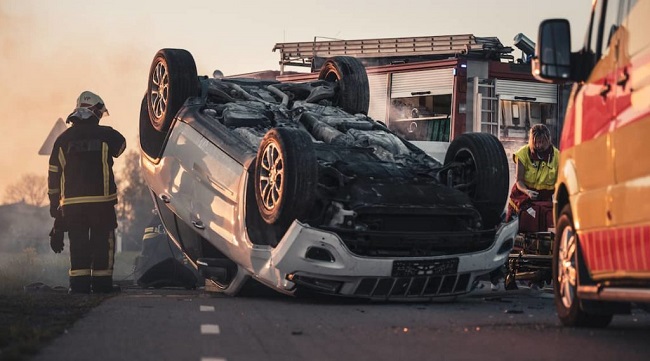The lifetime risk of dying in a car crash is little under one percent, but the risk of dying in a car crash in any one year is substantially lower. Understanding these numbers can help you make informed risk comparisons and provide you a deeper insight into the causes of accidental death.
Risk of Dying in a Car Crash Over the Course of a Lifetime: 1 in 101
Due to the two-year lag in reporting on fatalities from motor vehicle accidents, these figures will not be available until 2020. But, despite their limitations, these numbers do shed some light.

One in one hundred and one is the probability of dying in a car crash, according to the National Safety Council of the United States.
Hence, the average American has a 0.99% chance of dying in an automobile crash. Despite how high this seems, it’s essential to put everything in perspective.
Read Also:
- Randy Savage Garage Cause of Death
- Search For Whatever the Ship was Carrying
- Rivian Stock Falls Again as Production And Sales Woes Bite
The Meaning of Permanent Danger
The idea of lifetime risk can be difficult to grasp. Although everyone will eventually pass away, the likelihood of dying from a certain condition can be broken down by considering the lifetime risk.
The sad truth is that everyone will eventually pass away, but only about one percent of those deaths will occur due to automobile accidents. There is no comparison here with the annual risk of dying in a car crash.
The Probability of Dying in a Vehicle Accident in Relation to Other Threats to One’s Life
Although the odds of dying in a car accident are modest (just 1 in 101), they may nevertheless seem high to some. It has been reported by the National Safety Council of the United States that the typical American faces the following dangers during their lives:
- One in six people’s lives are cut short by heart disease (16.67%). The probability of dying in a car crash is increased by a factor of more than 16.
- One in seven people (14.29%) lose their lives to cancer, making it a leading cause of death overall.
- Death from an opioid overdose occurs in the United States at the rate of 1.49 per 100,000 people. That’s roughly 1.5 times as many as die in auto accidents each year.
- The death rate from falls is.98%, or 1 in 102 people, which is around the same as the death rate from automobile accidents.
- Aircraft – The National Safety Council of America claims that plane fatalities are too rare to include in risk estimates, therefore comparing the likelihood of dying in a car disaster with that of a plane crash is impossible.
One in Every 8,527 Deaths Each Year is Attributable to a Motor Vehicle Collision.
Your chances of dying in a car accident over the course of a year are more muddled, but the lifetime risk can help you comprehend your chances of dying in a crash at any point in your life span. Laws, speed restrictions, the economy, vehicle safety features, and a host of other variables alter this risk from one year to the next.
In any case, data for the year 2020 is already available. The National Highway Traffic Safety Administration (NHTSA) estimates that there will be 38,824 traffic-related fatalities in 2020.
According to the 2010 Census conducted by the United States government, the total population of the United States was 331,449,281. It’s estimated that in 2020, auto accidents will cause the deaths of 0.012% of Americans. The odds of that happening are 1 in 8,527.
One in 7,142,900 Per-Trip Risk of Dying in a Car Crash
Risk of dying in an automobile crash is another number that can be hard to pin down. Confusion arises from a number of sources, all of which are relevant here. Finding out how many people die in car accidents every mile is a necessary first step.
Then, you should learn the typical length of a single car trip taken by Americans. The numbers can be found, which is a huge relief. The National Highway Traffic Safety Administration estimates that for every 100,000,000 vehicle miles driven in 2020, there will be 1.34 fatalities.
The average distance driven by an automobile in a single day, for whatever purpose, is 10.7 miles, as reported by the Bureau of Transportation Statistics. If you divide that number by the 100 million vehicle miles listed above, you get a risk of dying in a car accident of 0.000014% for every time you get behind the wheel. The likelihood of such occurring is one in 7,142,900.
Every Mile Driven Increases Your Risk of Dying in a Car Crash by 1 in 74,626,866.
Using the National Highway Traffic Safety Administration’s figure of 1.34 fatalities for every 100 million miles travelled, you may calculate your risk of dying in an automobile crash every mile you drive. Driving one mile increases your risk of death by around one in 74,626,866.
Just remember that this is a mean. There can be significant differences in risk depending on the sort of mile you’re driving. The experience of driving one mile on an ice mountain road at night is vastly different from that of driving on a well-designed motorway during times of light traffic.
What Are the Odds of an Average Accident vs. Your Own Unique Danger?
Averages, not unique situations, form the basis for fatality statistics involving automobile collisions. The probability of dying in a car crash depends on a variety of factors, including how often you drive, what you do for a living, and how far you often travel.
Not only should you consider the traffic and weather conditions where you reside, but also your past driving record, whether or not you use a seatbelt, and how often you drink while driving. A person’s risk of being involved in a car accident and of dying as a result of such an accident can be significantly affected by all of the aforementioned variables.
Those who infrequently travel by automobile, for instance, have a substantially lower risk of dying in a car accident than the general population. On the other hand, the risk of death in a car accident may be significantly higher for someone who drives all day in terrible weather, doesn’t wear a seatbelt, and has a record of traffic offences.
It is estimated that reckless actions account for 45 percent of all fatal accidents.
In 2020, drivers engaging in at least one of the following dangerous habits were responsible for 45 percent of all vehicle deaths:
- Failure to use a safety belt
- The Dangers of Drinking and Driving
- Breaking the speed limit is illegal
Urban areas accounted for 69% of all fatalities.
The risk of being involved in a fatal car crash may be marginally higher in urban areas. Somewhat more than two thirds of traffic fatalities happened within or close to a major metropolis.
Car-Related Fatality Rates Broken Down by Age and Sex
The likelihood that you may perish in a car crash is affected not just by your driving record, but also by your age and gender. You should think about your own particular risk in light of this information.
More men than women die in fatal accidents.
When it comes to fatal car accidents, men have a much higher risk. According to data from the NHTSA, men account for 72.2% of fatalities while women make up only 27.8%. This means that men are 2.6 times more likely to perish in an automobile crash than women.
Read Also:
- Kernel Security Check Failure Windows 10
- How To Find Mac Address Windows 10?
- New Orleans Tornadoes Leave a Path of Destruction
Facts and Figures About Adolescent Traffic Fatalities
The teen road mortality rate is significantly higher than the rate for other age groups. Over 2,400 American teenagers between the ages of 13 and 19 were killed in automobile accidents in 2019, according to the Centers for Disease Control and Prevention.
Injuries among young people reached 258,000, with many of them requiring treatment in hospitals’ emergency departments. Over six teenagers died in automobile accidents every single day as a result. This age group has a mortality rate from automobile accidents that is three times that of those aged 20 and up.


